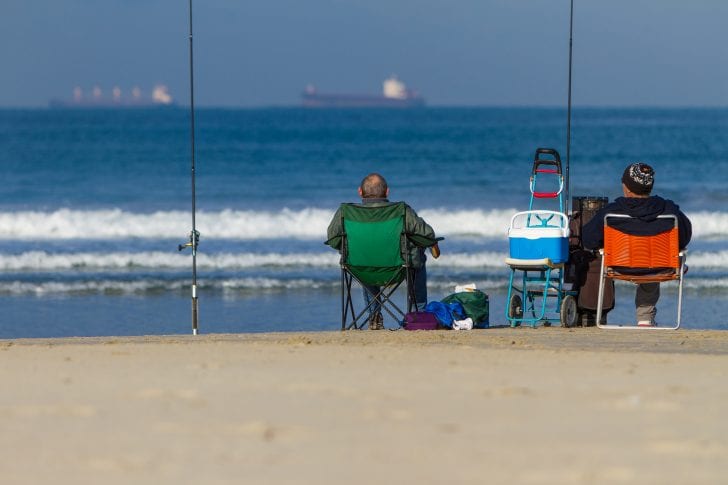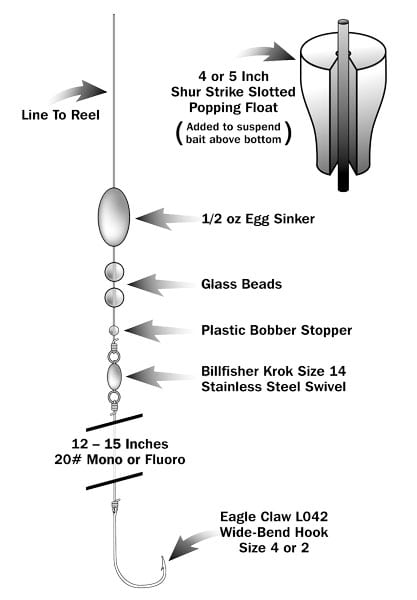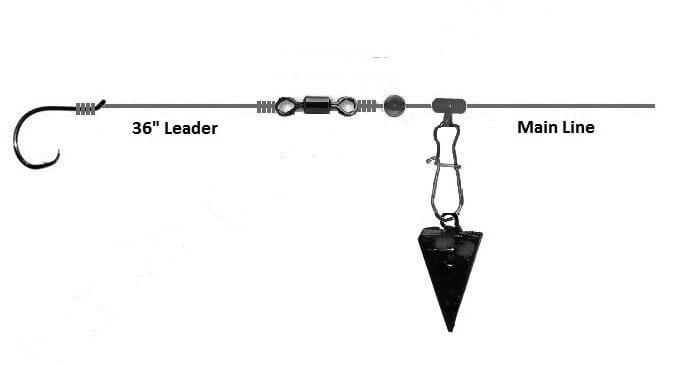When it comes to fishing, the two most frequent questions we are asked, “What kind of rig do you use, and where is the best place to fish?” Simply responding, “A Carolina rig or a fish finder rig” often doesn’t provide enough information; thus, a brief walk through or how-to is sometimes the best way to describe a rig. Use this quick reference guide for rigs to help make your next inshore fishing trip a success.
The Carolina Rig
A Carolina rig is one of the most commonly used bottom rigs. This rig is great for throwing around or up underneath docks, and it is also great for soaking a large chunk of blue crab or while waiting for a large redfish or bonnethead to appear.
When choosing the sinker, always select one to match the current. The most common choices are ¼- to ½-ounce sinkers, I rarely use one over 1 ounce.
I prefer a flat black Billfisher two-way swivel size 10 or 12. Flat black is my choice because if a bluefish or Spanish mackerel arrive, a shiny swivel sometimes becomes the target, and one bite from those guys and you’re tying on a new rig. Yozuri HD Carbon 20 pound is my choice for leader; when our water is all muddy, 20-pound mono will work also. A circle hook in size 2/0 is my preference; I use many hooks, but I fall back on an Eagle Claw Kahle hook often.
Piece these items together starting out with the egg sinker, run your main line from your reel through the egg sinker, and attach to one end of the barrel swivel using an improved clinch knot. Attach your leader – about 12 inches – to the other side of the barrel swivel with another improved clinch.
Then, tie your hook on and add a small split about 2 inches above the hook. The small split shot will assist in casting your rig, as it tangles less when you include a split shot.
The Popping Cork Rig
The popping cork rig is the best rig for covering lots of water by casting upstream and letting the current carry you, or assisting in floating a bait over an oyster rake and not getting caught up in the oyster rake.
Tie one of these on if you find yourself hung up on the bottom often. There are tons of corks on the market including ones that pop and ones that are stationary. I find that Bomber has made a superior product with its popping cork due to the Titanium wire.
You can tie it in a knot, and the wire will not bend. Along with a cork, you need some leader, split shot and a hook. I prefer the same leader, split shot and hook that I choose for my Carolina rig.
Attach your main line from your reel to the top of the popping cork, always making sure the weight on the cork is on the bottom so that it sets correctly in the water. Once attached to your mainline, add your leader to the bottom of the popping cork.
Use 36 to 48 inches of leader, which will assist you with keeping your bait on or near the bottom. Then, attach your hook and place a split shot above the hook. Fish on.
Fish Finder Rig
The fish finder rig is great for deeper water and also for fishing at the beach. It is a lot like the Carolina rig; you tie it the exact same way, except where you would place an egg sinker, use a fish finder (pictured).
This gives you the ability to switch weights as necessary for heavier current. A pyramid is the best choice of weight on a fish finder rig anywhere from 2 to 4 ounces.
I use a heavier grade of leader, up to 100-pound. This helps with abrasion resistance and keeps toothy critters from biting through it. I use simple monofilament as opposed to Yozuri HD Carbon. When using this rig,
I use just 6 inches of leader when tying to my swivel. The hook I choose is the Gamakatsu Octopus 4x Strong Circle Hook ranging in size 5/0 to 8/0. Remember to always match your bait to the hook.
Try these rigs on your next fishing trip, and hopefully you will be successful. Good luck and tight lines.
You may also enjoy reading: Artificial Shrimp & Winter Specks
CAMC Staff with Capt Simon Owens – revised 01-19





